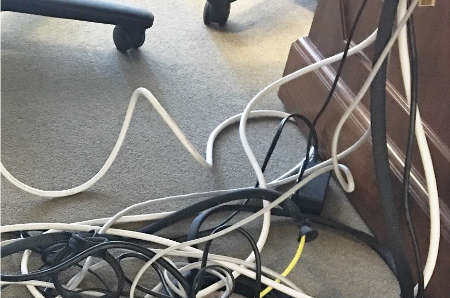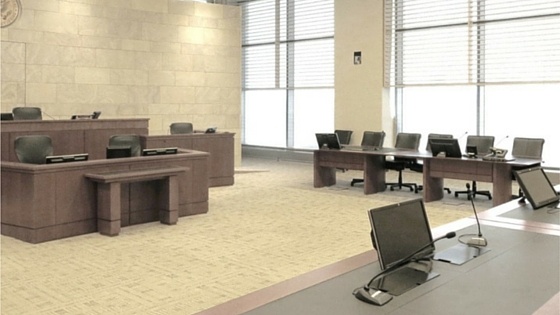Does your courtroom design layout impede safe egress for trial participants during a courtroom emergency? Does it present tripping hazards? This post will discuss these potential hazards and offer suggestions for resolving these problems.
Egress Safety
Egress safety from a courtroom must consider two different issues. The first is unique to courthouses: the secure movement of prisoners to and from courtrooms. You can read more about it in our recent security article. The second consideration, and the concern to be addressed now, is physical safety. This form of safety is not unique to courtrooms but includes general fire-life safety issues germane to all buildings.
While not unique to courtrooms, achieving this form of safe egress can be complicated by the need to keep prisoners apart from the other trial participants when leaving a courtroom in an emergency.
In a new courthouse, these two considerations are expected to be resolved by a courtroom design layout that includes a dedicated prisoner point of access and doors for the public that is correctly sized according to code. The latter is intended to allow safe egress in the case of a fire or other courtroom emergency. However, in older and especially historic courtrooms constructed before current security requirements and before current fire-life safety codes, secure and safe access points may not be present.
Are dedicated prisoner points of access and separate doors for the public present in your courtroom? If not, you must consider the alternatives. Let’s use the common situation of an older courtroom with limited access points.
Often, there are only two access points, one for the judge’s chambers behind the bench and one for the public at the opposite end of the courtroom. With this courtroom layout, the prisoner must enter and leave the courtroom through the public entry point. This is due to the absence of an adjacent holding cell or dedicated prisoner corridor and the related courtroom entry. To achieve a separation of the prisoner and public movement, timing is everything. The prisoner must be moved out of the courtroom at a different time from the public spectators to ensure they are kept apart.
That works well under normal circumstances. However, consider a courtroom emergency where everyone must exit the courtroom immediately. An escorted prisoner in the middle of 50 spectators, simultaneously rushing out of a courtroom, is neither a safe nor secure situation.
To avoid this possibility, courtroom security personnel and law enforcement officers should develop specific procedures to immediately clear a courtroom in an emergency – perhaps by using another less crowded point of access for the prisoner, if available. The bottom line objective is to ensure that the courtroom emergency evacuation occurs in a rapid yet highly planned and controlled manner.
Additionally, to further ensure the safety of all trial participants, courtroom security personnel should develop specific procedures intended to assist people with disabilities in clearing a courtroom in an emergency immediately.
Furniture placement must also consider security and physical safety. Providing adequate space around furniture used by the prisoner is critical for security. Providing sufficient space between all furniture components is essential for egress safety. Furniture components placed too close together can pose an egress hazard, especially for people with disabilities.
Appropriate security spacing between furniture components should also equal adequate egress spacing for emergencies. However, fire-life safety codes should be consulted when in doubt and take precedence.
______________________________________________________________
Tripping Hazards During a Courtroom Emergency
The use of computers for evidence presentation and electronic recording of proceedings continues to expand and is now the norm in many courtrooms. The courtroom computer system used for these purposes is typically linked to monitors at the judge’s bench, clerks’ area, attorneys’ tables, and the jury box by cables.
Many courts avoid wireless connectivity because of concerns about security breaches. Newer courthouses with cellular or raised floor systems can generally accommodate cables and wires below the floor. In older courthouses built with simple floor slabs, it is sometimes difficult to connect the computer systems without cables, wires, and raised junction boxes located at least partially above the floor.
I often visit courtrooms, where cables and wires are below the attorneys’ tables. I also find raised junction boxes inadvertently positioned in an aisle. Sometimes, I even find cables running across the aisle from the attorneys’ table to the clerks’ stations in front of the bench. These and similar technology additions to an existing courtroom can potentially produce a tripping hazard that should be recognized and avoided.
As shown in the photo below, this is not a safe situation to allow during the normal conduct of a trial. It is particularly unsafe when present during the evacuation of a courtroom for an emergency.

While it may not be possible to correct this potential hazard by installing cables and wires below an older floor structure, at a minimum, cables, and wires should be grouped together and covered by a rubber guard or installed as a flat wire system below the carpet. Raised junction boxes should never be allowed to remain in an aisle. If there is a need to periodically move furniture that is normally located above a junction box, thereby leaving it exposed, an entirely different location may need to be considered for the box.
A Combined Approach
Security and physical safety are both critical for a courtroom design layout; in many cases, they go hand-in-hand. Although eliminating security and physical safety hazards is challenging to achieve in some courthouses, there are rarely situations where thoughtful planning mixed with a dose of creativity cannot provide a satisfactory resolution.






.jpg)
.jpg)
.jpg)
.jpg)
.jpg)
.jpg)


.jpg)
.jpg)
.jpg)
-1.jpg)
.jpg)
.jpg)
.jpg)
.jpg)

